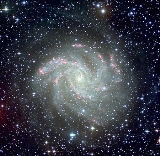
NGC 6946
Encyclopedia
NGC 6946, is an intermediate spiral galaxy
about 22 million light-year
s away, on the border between the constellation
s Cepheus
and Cygnus
. It was discovered by William Herschel
on September 9, 1798. NGC 6946 is highly obscured by interstellar matter of the Milky Way galaxy, as it is quite close to the galactic plane
. Nine supernovae (SN 1917A
, SN 1939C
, SN 1948B, SN 1968D, SN 1969P, SN 1980K, SN 2002hh, SN 2004et, and SN 2008S) have been observed in NGC 6946.
There is polarisation data within ranges 0.17-0.18 m and 0.21-0.23 m, observed in 2003 by WSRT
.
Intermediate spiral galaxy
An intermediate spiral galaxy is a galaxy that is in between the classifications of a barred spiral galaxy and an unbarred spiral galaxy. It is designated as SAB in the galaxy morphological classification scheme.-Grades:...
about 22 million light-year
Light-year
A light-year, also light year or lightyear is a unit of length, equal to just under 10 trillion kilometres...
s away, on the border between the constellation
Constellation
In modern astronomy, a constellation is an internationally defined area of the celestial sphere. These areas are grouped around asterisms, patterns formed by prominent stars within apparent proximity to one another on Earth's night sky....
s Cepheus
Cepheus (constellation)
Cepheus is a constellation in the northern sky. It is named after Cepheus, King of Aethiopia in Greek mythology. It was one of the 48 constellations listed by the 2nd century astronomer Ptolemy, and remains one of the 88 modern constellations.-Stars:...
and Cygnus
Cygnus (constellation)
Cygnus is a northern constellation lying on the plane of the Milky Way. Its name is the Latinized Hellenic word for swan. One of the most recognizable constellations of the northern summer and autumn, it features a prominent asterism known as the Northern Cross...
. It was discovered by William Herschel
William Herschel
Sir Frederick William Herschel, KH, FRS, German: Friedrich Wilhelm Herschel was a German-born British astronomer, technical expert, and composer. Born in Hanover, Wilhelm first followed his father into the Military Band of Hanover, but emigrated to Britain at age 19...
on September 9, 1798. NGC 6946 is highly obscured by interstellar matter of the Milky Way galaxy, as it is quite close to the galactic plane
Galactic plane
The galactic plane is the plane in which the majority of a disk-shaped galaxy's mass lies. The directions perpendicular to the galactic plane point to the galactic poles...
. Nine supernovae (SN 1917A
SN 1917A
SN 1917A is a supernova that occurred in the Fireworks Galaxy on 19 July 1917. Discovered by George Willis Ritchey, it reached a peak magnitude of 14.6 mag and is 37"W and 105"S of the core of the Fireworks Galaxy...
, SN 1939C
SN 1939C
SN 1939C was a supernova in the Fireworks Galaxy first discovered by Fritz Zwicky on 17 July 1939. With a right ascension of 20:34:23.0 and a declination of +60:09:37.3, it lies 215"W and 24"N from the center of the Fireworks Galaxy. It peaked at a magnitude of 13.0 mag....
, SN 1948B, SN 1968D, SN 1969P, SN 1980K, SN 2002hh, SN 2004et, and SN 2008S) have been observed in NGC 6946.
There is polarisation data within ranges 0.17-0.18 m and 0.21-0.23 m, observed in 2003 by WSRT
Westerbork Synthesis Radio Telescope
The Westerbork Synthesis Radio Telescope is an aperture synthesis interferometer near camp Westerbork, north of the village of Westerbork, Midden-Drenthe, in the northeastern Netherlands. It consists of a linear array of 14 antennas with a diameter of 25 metres arranged on a 2.7 km East-West line...
.
External links
- SEDS: Spiral Galaxy NGC 6946
- NGC6946
- Supernova 2008S in NGC 6946 (supernovae.net)
- NASA APOD – 2011 Jan 01

